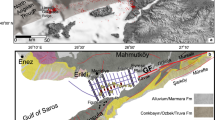Abstract
Data recorded by a seismic network deployed the day after the 2004 Mid Niigata Prefecture Earthquake (M6.8) in central Japan are used to determine the major source faults responsible for the mainshock and major aftershocks. Using this high-resolution seismic data, three major source faults are identified: two parallel faults dipping steeply to the west located 5 km apart, and the other dipping eastward and oriented perpendicular to the west-dipping faults. The analysis also reveals that the lateral variation in seismic velocity observed at the surface extends to a depth of 15 km, encompassing the source area of the mainshock. This strong heterogeneity of the crust, related to the complex geological and tectonic evolution of the area, is considered to be responsible for the prominent aftershock activity following the 2004 Niigata event.





Similar content being viewed by others
References
Coordinate Committee for Earthquake Prediction Research (2004) Observations of the 2004 Mid-Niigata Prefecture Earthquake. http://www.eri.u-tokyo.ac.jp/YOTIKYO/niigata/index-open.htm
Earthquake Research Institute, University of Tokyo (2004) A report for the 160th Coordinate Committee for Earthquake Prediction (Nov. 4, 2004). http://www.eri.u-tokyo.ac.jp/hirata/chuetsu/0401104yotiren1.htm
Geological Information Center (1991) Geological Map of Nagaoka, 1:50,000
Headquarters for Earthquake Research Promotion (1999) The Promotion of Earthquake Research, Basic comprehensive policy for the promotion of earthquake observation, measurement, surveys and research (in Japanese with English translation)
Hirata N, Matsu’ura M (1987) Maximum likelihood estimation of hypocenter with origin time eliminated using non-linear inverse technique. Phys Earth Planet Int 47:50–61
Hirata N, Ohmi S, Sakai S, Katsumata S, Matsumoto S, Takanami T, Yamamoto A, Nishimura T, Iidaka T, Urabe T, Sekine M, Ooida T, Yamazaki F, Katao H, Umeda Y, Nakamura M, Seto N, Matsushima T, Shimizu H, Japanese University Group of the Urgent Joint Observation for the 1995 Hyogo-ken Nanbu Earthquake (1996) Urgent joint observation of aftershocks of the 1995 Hyogo-ken Nanbu Earthquake. J Phys Earth 44:317–328
Hirata N, Sato H, Research Group for the Urgent Aftershock Observation of the EarthquakeResearch Institute, University of Tokyo (2005) The 2004 Mid-Niigata Prefecture Earthquake – Source faults estimated by the subsurface structure and aftershocks. Kagaku 75:149–151
Ikeda Y, Imaizumi T, Togo M, Hirakawa H, Miyauchi Y, Sato H (2002) Atlas of Quaternary thrust faults, Tokyo University Press, Tokyo, 254p
Iio Y, Sagiya T, Kobayashi Y (2004) Origin of the concentrated deformation zone in the Japanese Islands and stress accumulation process of intraplate earthquakes. Earth Planets Space 56:831–842
Kato A, Kurashimo E, Hirata N, Iwasaki T, Kanazawa T (2005) Imaging the source region of the 2004 Mid-Niigata prefecture earthquake and the evolution of a seismogenic thrust-related fold. Geophys Res Lett, 32: L07307, doi: 10.1029/2005 GL022366
Matsuda T (1995) Active faults, Iwanami-shinsho 423, Iwanami Shoten, Tokyo, 242p
Maruyama T, Fusejima Y, Yoshioka T, Awata Y, Matsu’ura T (2005) Characteristics of surface rupture associated with the 2004 Mid Niigata Prefecture earthquake, central Japan and their seismotectonic implications, submitted to Earth Planets and Space
Natural Gas Mining Society and the Society of Exploration for Oil in the Continental shelf (1992) Oil and natural gas resources in Japan (revised), 520p
Obara K, Hori S, Kasahara K, Okada Y, Aoi S (2000) Hi-net: High sensitivity seismograph network in Japan. Eos Trans AGU, 81(48), Fall Meet. Suppl., Abstract S71A-04
Sakai S., Hirata N, Kato A, Kurashimo E, Iwasaki T, Kanazawa T (2005) Multi-fault system of the 2004 Mid-Niigata Prefecture Earthquake and its aftershocks, Earth Planets and Space, 57, in press
Sato H, (1994) The relationship between late Cenozoic tectonic events and stress field and basin development in northeastern Japan. J Geophys Res 99:22261–22274
Sagiya T, Miyazaki S, Tada T (2000) Continuous GPS array and present-day crustal deformation of Japan. Pure Appl Geophys 157:2303–2322
Takeda T, Sato H, Iwasaki T, Matsuta N, Sakai S, Iidaka T., Kato A (2004) Crustal structure in the northern Fossa Magna region, central Japan, from refraction/wide-angle reflection data, Earth Planets Space, 56:1293–1299 (in press)
Tsutsumi H, Togo M, Watanabe M, Kin T, Sato N (2001) Active fault map in urban area: Nagaoka, Technical report of the Geographical Survey Institute, D.1, No. 388
Zhang Z, Thurber CH (2003) Double-difference tomography: the method and its application to the Hayward fault, California. Bull Seism SocAm. 93:1875–1889
Acknowledgements
This work is supported by a Grant-in-Aid for Special Purposes (16800054), and the Special Coordination Funds for the Promotion of Science and Technology (MEXT, Japan) titled as the Urgent Research for the 2004 Mid-Niigata Prefecture Earthquake, and a grant offered under the Earthquake Prediction Research program of the MEXT, Japan. Gratitude is extended to T. Iwasaki, T. Kanazawa, H. Hagiwara, T. Iidaka, T. Igarashi and staff of the Earthquake Research Institute, University of Tokyo, for valuable discussion
Author information
Authors and Affiliations
Corresponding author
Rights and permissions
About this article
Cite this article
Hirata, N., Sato, H., Sakai, S. et al. Fault system of the 2004 Mid Niigata Prefecture Earthquake and its aftershocks. Landslides 2, 153–157 (2005). https://doi.org/10.1007/s10346-005-0050-8
Received:
Accepted:
Published:
Issue Date:
DOI: https://doi.org/10.1007/s10346-005-0050-8




